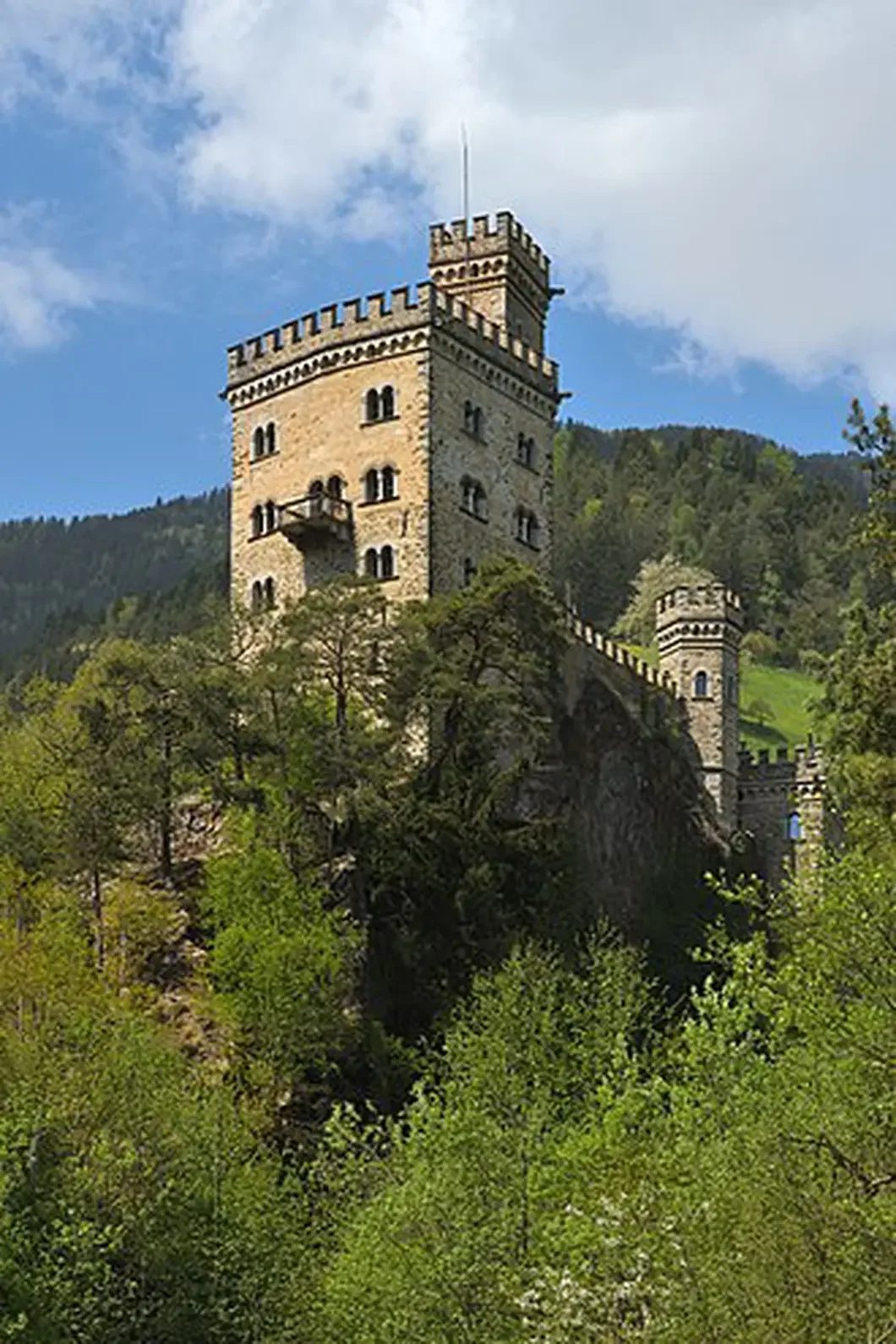Gernstein Castle (also Gerstein or Garnstein; Italian Castello di Gernstein or Castel Tina) is a neo-Romanesque castle between Villanders and Latzfons near Klausen in South Tyrol.
 |  |
Gernstein Castle (also Gerstein or Garnstein; Italian Castello di Gernstein or Castel Tina) is a neo-Romanesque castle between Villanders and Latzfons near Klausen in South Tyrol.
The castle is located in the Tinnetal above the Tinnebach and dates back to the 12th century. Its task was to guard the ancient route from Brixen over the mountains to the south and was first mentioned in 1215 in connection with the "Garre" family as "Garrenstein"[1]. Since Klausen and the area around Villanders were important due to the wealth of ore and mining, the fortifications were also strategically important[2]. After the Garrenstein family died out, the castle passed to the Lords of Voitsberg, who received the castle as a fief from the Prince-Bishops of Brixen. In 1356, the Voitsbergers (now: Garnsteiners) rebelled against the diocese of Brixen and lost the castle, probably after a siege by Prince-Bishop Matthäus an der Gassen[3]. In 1373, Bishop Johann Ribi of Lenzburg enfeoffed his nephew Johann V. Segesser with all the goods of the deposed Hans von Garrenstein, i.e. with the castle and lordship of Garrenstein and with the court of Latzfons. The fortress burned down shortly before 1389[4]. In 1389, the castle was given as a pledge (no longer as a fief) to the Lords of Villanders.
In 1550, the Knights of Heydorf received it again as a fief from the Prince-Bishop of Brixen, Cristoforo Madruzzo,[5] but the castle fell into ruins from the 16th century onwards.
From 1607 to 1797, Garnstein was given to Ludwig Lindner, the chamberlain of the Bishopric of Brixen, and his descendants, who bore the title "von Gerrenstein"[6]. In 1777, Franz Joseph Anton Bernwerth von Gernstein served as the court administrator of the Altenburg estate in Eppan.[7]
Postcard of Gernstein Castle near Klausen, ca. 1907
In 1880, the ruins were bought by the Prussian Lieutenant General Friedrich von Gerstein-Hohenstein (1814–1891) and rebuilt in the historicist neo-Romanesque style. The reason for the purchase was that Lieutenant General Gerstein-Hohenstein wanted to acquire a castle that had always borne his family's name. There is no other historical connection between the castle and the Prussian noble family. Since then, the name "Gernstein" has prevailed.
In 1919, Gernstein was confiscated by the Italian occupying forces as "German property".[8]
The castle has been privately owned since 1970 and cannot be visited.
Due to its wildly romantic location and the picturesque beauty of the historicist reconstruction, Gernstein Castle is a popular photo subject.
Literature
Oswald Trapp: Garnstein. In: Oswald Trapp (ed.), Tiroler Burgenbuch. IV. Band: Eisacktal. Verlagsanstalt Athesia, Bozen 1977, pp. 174–182.
Weblinks
Commons: Gernstein Castle – collection of images, videos and audio files
Entry: in the monument browser on the website of the South Tyrolean State Monument Office
Individual references
1: Oswald Trapp: Tyrolean Castle Book: Eisacktal, Volume 4, p. 174
2: The first documented mention (Memento from January 21, 2012 in the Internet Archive)
3: Trapp, Castle Book: Eisacktal, p. 175
4: Genealogical Handbook of Swiss History, Volume III, p. 198
5: Heraldic-Genealogical Society Adler, New Yearbook 1891, p. 73
6: Trapp, Castle Book: Eisacktal, p. 178
7: Hannes Obermair: Nonsberger Regesten. The Unterweg-Perger Archive in Proveis (1274–1777). In: Der Schlern. 66th year, no. 9, 1992, pp. 587–600, reference: p. 598, no. 36 (academia.edu [PDF]).
8: Trapp, Burgenbuch: Eisacktal, p. 179.



Leave a Comment